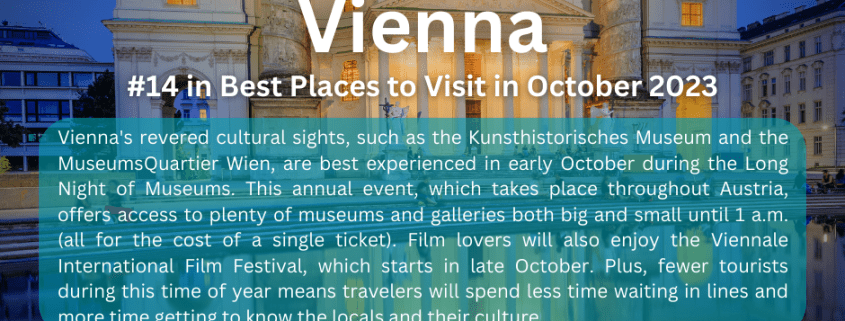Vienna #14 in Best Places to Visit in October 2023
Why Go To Vienna
History is at the heart of Vienna both literally and figuratively. The narrow streets of the Innere Stadt (Inner City) snake through antiquated buildings, providing an atmosphere so authentic that you almost expect a Vienna native like composer Wolfgang Amadeus Mozart or psychologist Sigmund Freud to round a cobblestone corner and greet you with “guten tag.” Extravagant baroque palaces from the Habsburg Monarchy loom over the city, just as Mozart’s classical arias pour from contemporary cafes. If it’s culture you seek, you’ll find it here.
But there’s more to this city than just music and monarchs. Vienna is also a great place to spend some cash, with independent bookstores competing for business alongside haute couture. There are also a surprising number of attractions for young ones, including an amusement park and a top-notch zoo. And although many Viennese retire early in the night, that doesn’t mean you have to; sneak out to one of the bars along the city’s Bermuda Triangle, or drop by one of the wine taverns skirting the Vienna Woods.
Best Months to Visit
The best time to visit Vienna is from April to May or September to October. The mild weather in spring and fall brings mild crowds. Most visitors aim to enjoy the warm, sunny weather that Vienna experiences in the summer months. Between June and August, you can expect the city to fill up and room rates to skyrocket. December also sees a spike in tourism since many Europeans flock to the city for a taste of Christmas spirit served Viennese-style, but chilly temperatures can be a deterrent.
Culture & Customs
You will find that most Viennese tend to dress conservatively. If you are traveling on business, make sure to wear proper business attire, such as a dark-colored suit or dress.
If you’re dining out in Vienna, it is polite to eat most of your food with your fork; a knife is used to hold food in place while using the side of a fork in place of a knife. If you are dining alongside Austrians, do not begin eating until the host says “Gesegnete Mahlzeit” (bless this meal) or “Guten Appetit” (enjoy your meal). It’s not polite to leave food on your plate; however, if you’re full, make sure to leave your knife and fork side by side on your plate. If you are invited to dinner, don’t fight for the bill. Your host expects to pay. If you are paying the bill, gratuity – normally 10 percent – is usually already included. However, it is polite to round the bill up or leave an extra 5 percent for good service.
What to Eat
Dining on delectable Viennese cuisine is one of the city’s major must-dos. But vegetarians beware: Much of Austrian cuisine centers on meat. Traditional Austrian taverns (known as beisls) serve up hearty portions of Tafelspitz (boiled beef), goulash (a rich stew made primarily from beef and potatoes) and wiener schnitzel (deep-fried, breaded veal). If you’re looking for an authentic Austrian meal, recent visitors recommend Lugeck and Ofenloch, both of which are located in Innere Stadt. If you’re looking to save some coin, though, you may want to avoid the Innere Stadt neighborhood. Instead, check out the streets just beyond the city center. Travelers recommend Motto in Weiden and Gmoakeller in Landstrasse. Over the past few years, Vienna has also seen the rise of international cuisines as well, ranging from Asian to Italian fare. No matter where you decided to dine, carry cash; some Viennese restaurants do not accept credit cards.
When it’s time for dessert, cafes cater to customers with a sweet tooth, serving wide assortments of pastries like gugelhupfs (marbled bundt cakes), sacher-faschingskrapfens (sugared doughnuts) and apple strudel. The Viennese are also big fans of wine (more than 1,700 acres of vineyards exist within the city limits and the wine can be enjoyed in tasting rooms, bars and eateries) and strong beer.
Safety
Vienna is considered one of the safest capitals in Europe and it often appears highly on many best quality of life rankings. Still, travelers should use common sense and keep an eye out for petty theft. The Prater amusement park and mass transit are popular hunting grounds for pickpockets.
Getting Around Vienna
The best ways to get around Vienna are on foot and by public transportation. Many historic attractions can be found within the compact Innere Stadt and are easy to reach with just a sturdy pair of walking shoes. But if you are interested in exploring some of the more remote districts, the city’s subway, bus and streetcar routes will get you where you need to go. Taxis are abundant as well. There are also several methods of public transportation connecting Vienna to the Vienna International Airport (VIE) – about 12 miles southeast of the city center – including the City Airport Train (which costs 11 euros for a one-way ride).
On Foot
You can really get a sense for this city by walking. In fact, many of Vienna’s historic attractions – including St. Stephen’s Cathedral and Hofburg Palace – are just a few paces from one another in the Inner City.
Bus and Streetcar
Vienna’s convenient and easy-to-use public transit, the Wiener Linien, is great for exploring the outer limits. Bus and streetcar (strassenbahnen) routes snake throughout the city. You can transfer between modes using the same ticket, which are available at every stop. Single rides cost 2.20 euros or you can purchase a one-, three- or eight-day unlimited pass (prices range from around 7 to 40 euros, depending on the length of validity). Your Vienna Card can also be used on public transport. Should you happen to miss the last streetcar or bus, you can hop on special night buses (marked with the letter “N”), which operate fairly frequently along designated routes.
U-Bahn and S-Bahn
The Wiener Linien also operates a subway system (the U-Bahn), which services the city and a speedy light-rail system (the Schnellbahn or S-Bahn) that services the suburbs. Fares and transfers are the same for the U-Bahn and S-Bahn as they are for the buses and streetcars, and you can use the same tickets on all forms of public transportation.
Taxi
Taxis are easy to find in Vienna, but you should only use them when you really need to because rates add up quickly. Agree on a fare before getting into the cab, otherwise you could be overcharged. It’s also a good idea to ask your concierge what the going rate is to and from various sites. Vienna is also home to ride-sharing services like Uber.
Bike
Like many European cities, Vienna is very bike-friendly, boasting more than 150 miles of marked bicycle paths. In fact, many Viennese forgo their cars in favor of bicycles. You are also allowed to carry bikes on public transportation for free. You’ll find plenty of rental agencies around Prater and along the Danube Canal, and rates begin at around 40 euros per day.
Car
Those of you who opt for your own set of wheels will soon discover why many Viennese hardly use their cars: Vienna’s streets are narrow and difficult to navigate, while traffic in the city center can be a nightmare. Also, unless you buy a parking ticket – which you can purchase at most newsstands and tobacco shops – you will not be able to park anywhere in the central neighborhoods. If you’re planning a scenic country drive, consider waiting to rent a car until you’re ready to leave Vienna; that way, you can avoid having to park in the city.
Rental agencies can be found at the airport, but you’ll have to pay an extra 6 percent surcharge on top of an already steep 21 percent tax on all rentals. Rates are cheaper in town. To rent a car you will need to present a passport as well as a driver’s license that is at least a year old.
Entry & Exit Requirements
U.S. citizens can enter the country for up to 90 days without a visa. If you plan to stay longer, you must obtain the proper visa from the Austrian Embassy prior to departure. You will need a passport that is valid for at least six months after your return, however. For more information concerning entry and exit requirements for Austria, visit the U.S. State Department’s website.
Start Saving with iTravelDirect’s Exclusive Travel and Lifestyle Benefits Membership
CLICK HERE to Test-Drive our Guaranteed Savings
We offer a 110% Price Guarantee – Find a lower price anywhere online and we will refund you 110% of the difference.
CLICK HERE for a full list of services and Membership Discounts.
When you join iTravelDirect, you’ll have full access to all club benefits.
Your membership gives you the freedom to travel when you want, to where you want.
And you won’t find lower rates anywhere, guaranteed. So, pack your bags and start planning that vacation of a lifetime today!












Leave a Reply
Want to join the discussion?Feel free to contribute!